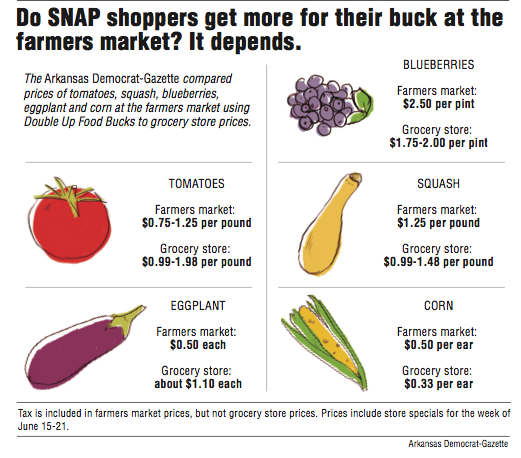Bob Barnhill, owner of Barnhill Orchards near Lonoke, sifts through a handful of silver and gold $2 tokens. On this Sunday morning at Bernice Garden Farmers Market in downtown Little Rock, Barnhill and his granddaughter have sold $40 worth of produce to shoppers who collect federal food assistance. As part of a new program called Double Up Food Bucks, Supplemental Nutrition Assistance Program (SNAP) shoppers can use up to $20 in SNAP money and receive a matching amount to spend on produce at participating farmers markets.
"When we get the double up [coins], we get more business," Barnhill says. "Our stuff is relatively expensive. ... The corn was picked this morning, as opposed to in Florida two weeks ago."
One in six Arkansas residents receives SNAP benefits. At the moment, 61 farmers markets in the state accept SNAP money, and 18 are participating in the double up program. The hope is that it can help boost farmers' incomes and get more people with low incomes eating more fresh fruits and vegetables.
Most people on food assistance can't afford to shop at farmers markets, due to convenience and because they can buy more at a supermarket, according to Laurie Knight, a nutrition instructor at the University of Arkansas at Little Rock. But local produce often contains more nutrients, in part because fluorescent lighting in grocery stores robs produce of nutrients the longer it is on display, she says.
"Programs like this are great, because it doesn't penalize [SNAP recipients] for spending more money," Knight says. "They actually get the opportunity to buy [fresh] food."
But do the extra funds in this program succeed at making produce at farmers markets accessible to SNAP recipients who are trying to stretch their money? The Arkansas Democrat-Gazette compared some of the prices with local supermarkets.
Let's start with everyone's summer favorite, tomatoes. A basket of Barnhill tomatoes, weighing about two pounds, costs $5, or $2.50 a pound. With the Double Up benefits, the cost is reduced to $1.25 per pound, including tax. At the Little Rock Farmers Market, south Arkansas tomatoes sold at Ricks Farm Stand for $1.50 per pound. With the double up bucks, the cost is 75 cents per pound.
At the Kroger on 1100 E. Roosevelt Road in Little Rock, tomatoes from Five Star Farms in Canada go for $1.89 per pound, before tax. Tomatoes from Grainger County, Tenn., are 99 cents per pound. At the Wal-Mart Neighborhood Market on 2510 Cantrell Road in Little Rock, Arkansas-grown tomatoes cost $1.98 per pound. Tomatoes from Lakeside produce, out of either California or Mexico, are $1.68 per pound.
Some of the other items available at the Barnhill stand include squash ($5 for a 2-pound box), blueberries ($5 per pint), corn ($1 per ear) and eggplant ($1 each). With double up bucks, those costs are cut in half.
At Kroger the day we visited, squash was priced 99 cents per pound and pints of blueberries were on sale for $2. Corn, also on sale, was six ears for $2, or 33 cents an ear. Finally, eggplant was $1.69 per pound, making for an average of $1.10 per individual eggplant. At Wal-Mart, squash was $1.48 per pound, blueberries were $1.75 per pint, corn was 33 cents per ear and eggplant was $1.78 per pound.
Based on these numbers, it appears the promoters of the Double Up Food Bucks program are right, in part. Shopping at local farmers markets gives SNAP recipients more bang for their buck with tomatoes and eggplant. Corn and blueberries cost more and squash is about the same, depending on where you shop.
There are participating farmers markets in Rogers, Siloam Springs, Harrison, Clarksville, Fort Smith, Paris, Clinton, Marshall, Fayetteville and Springdale. Others are Jonesboro, Nashville, Hot Springs, Pine Bluff, Rison and three in Little Rock. More information can be found at tinyurl.com/ztdnc5v.
Food on 06/29/2016
